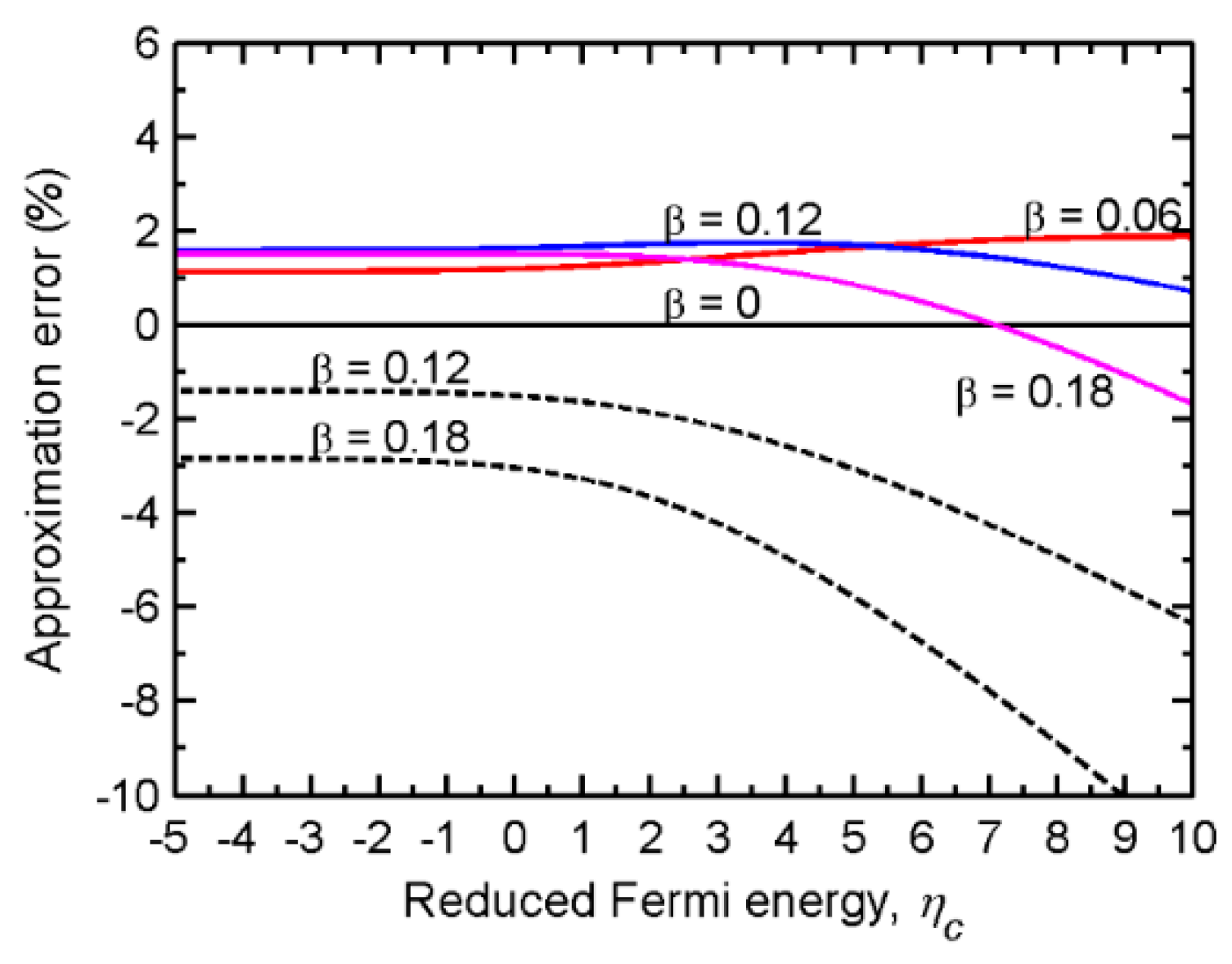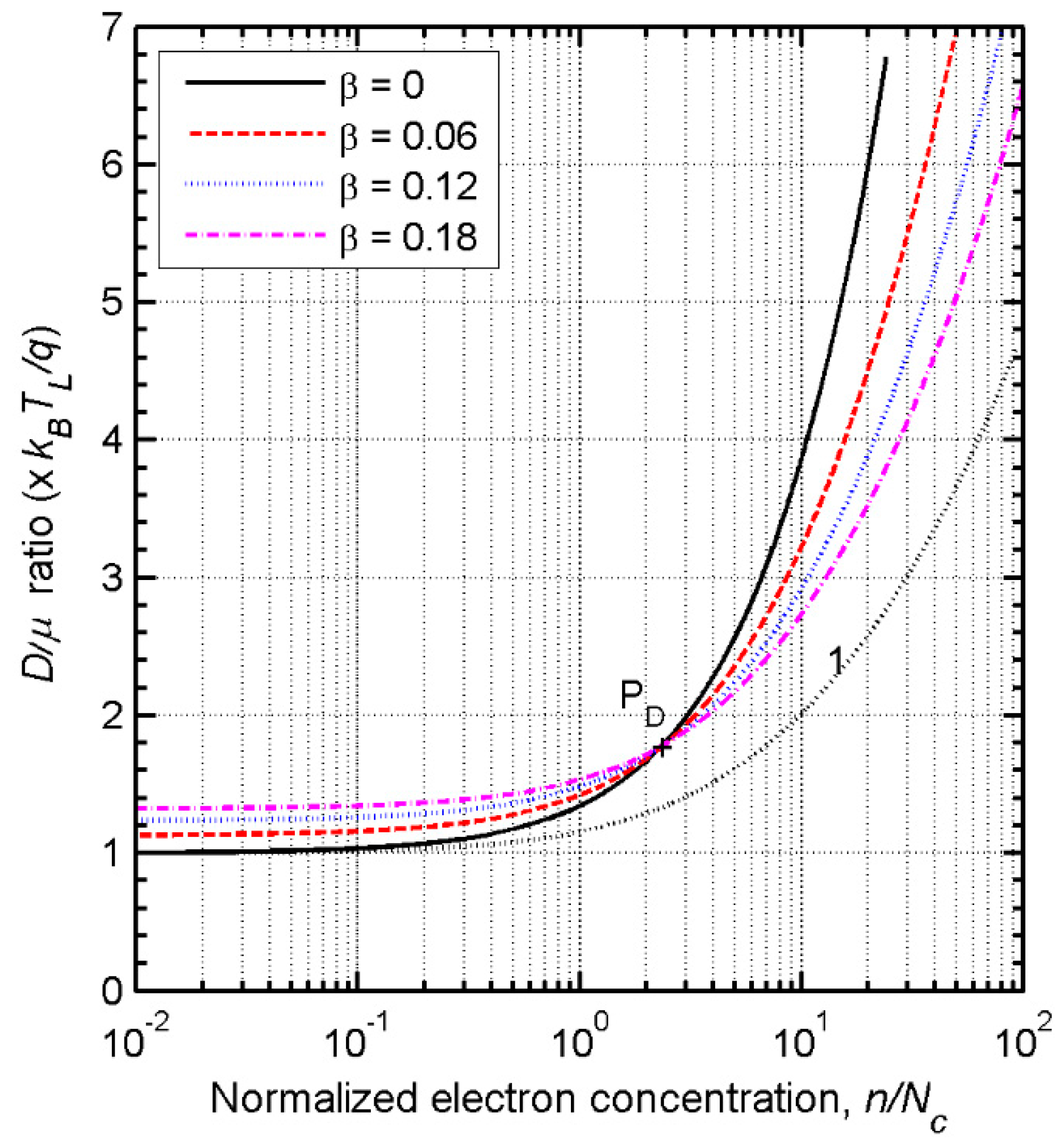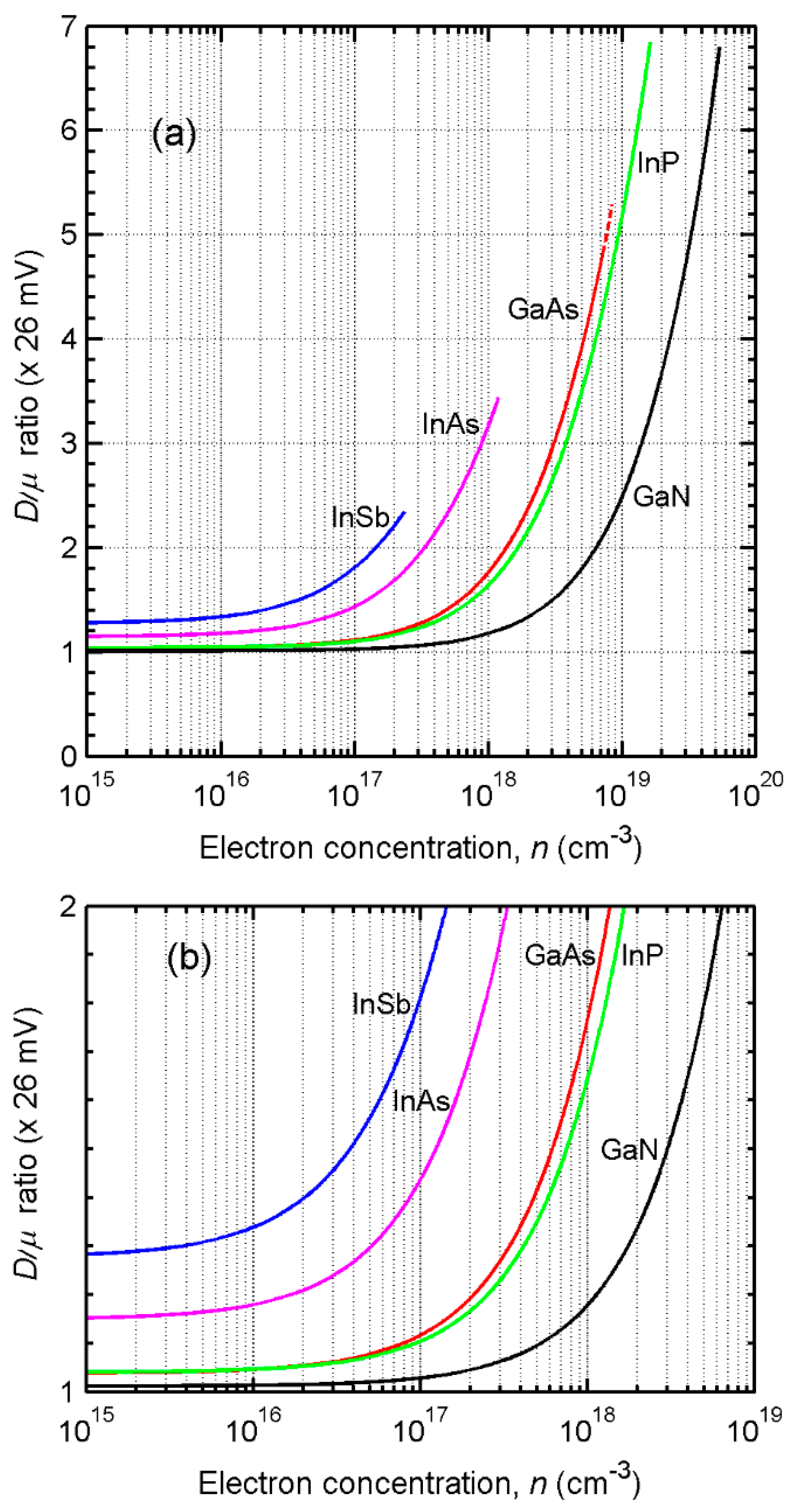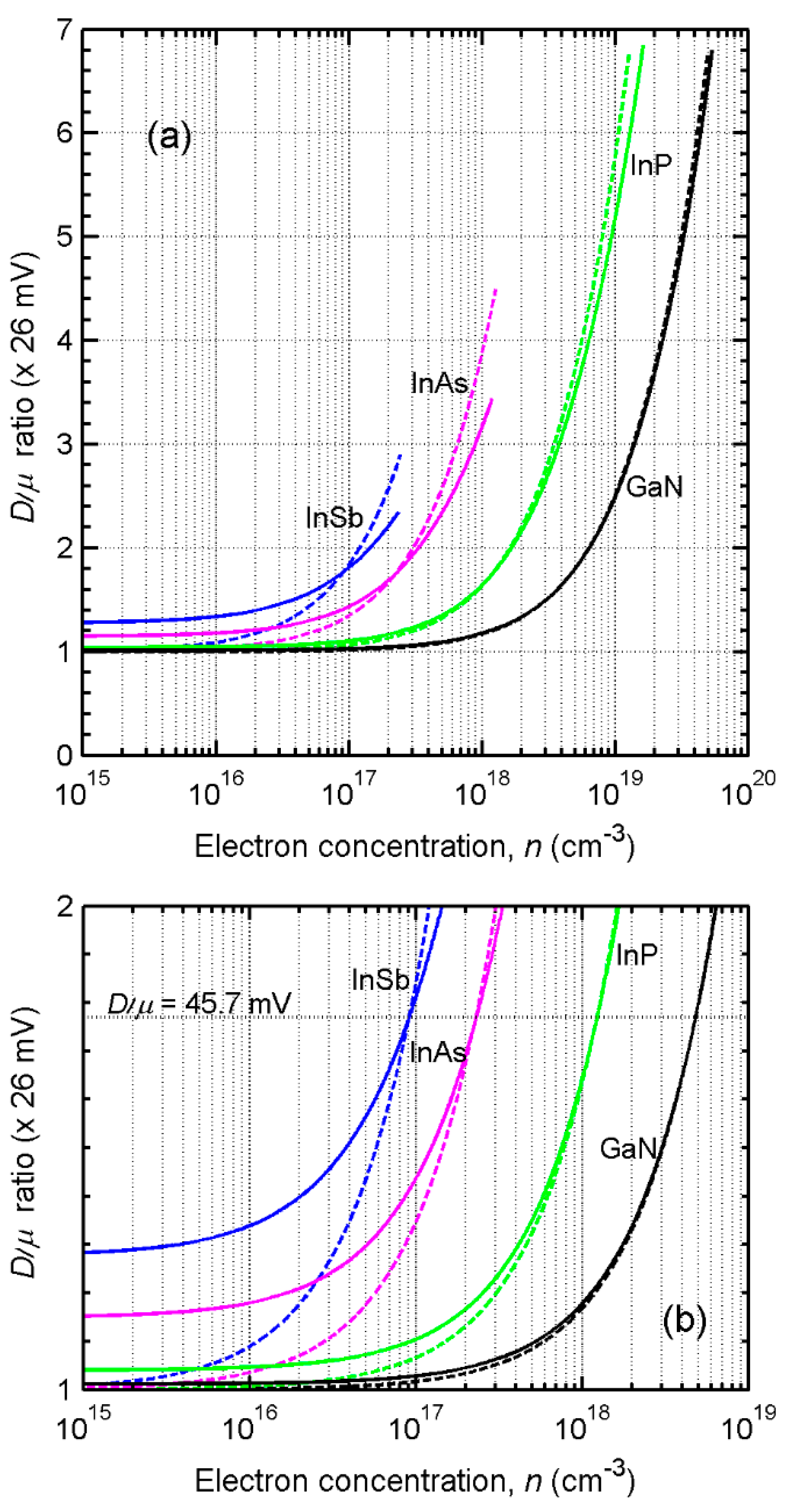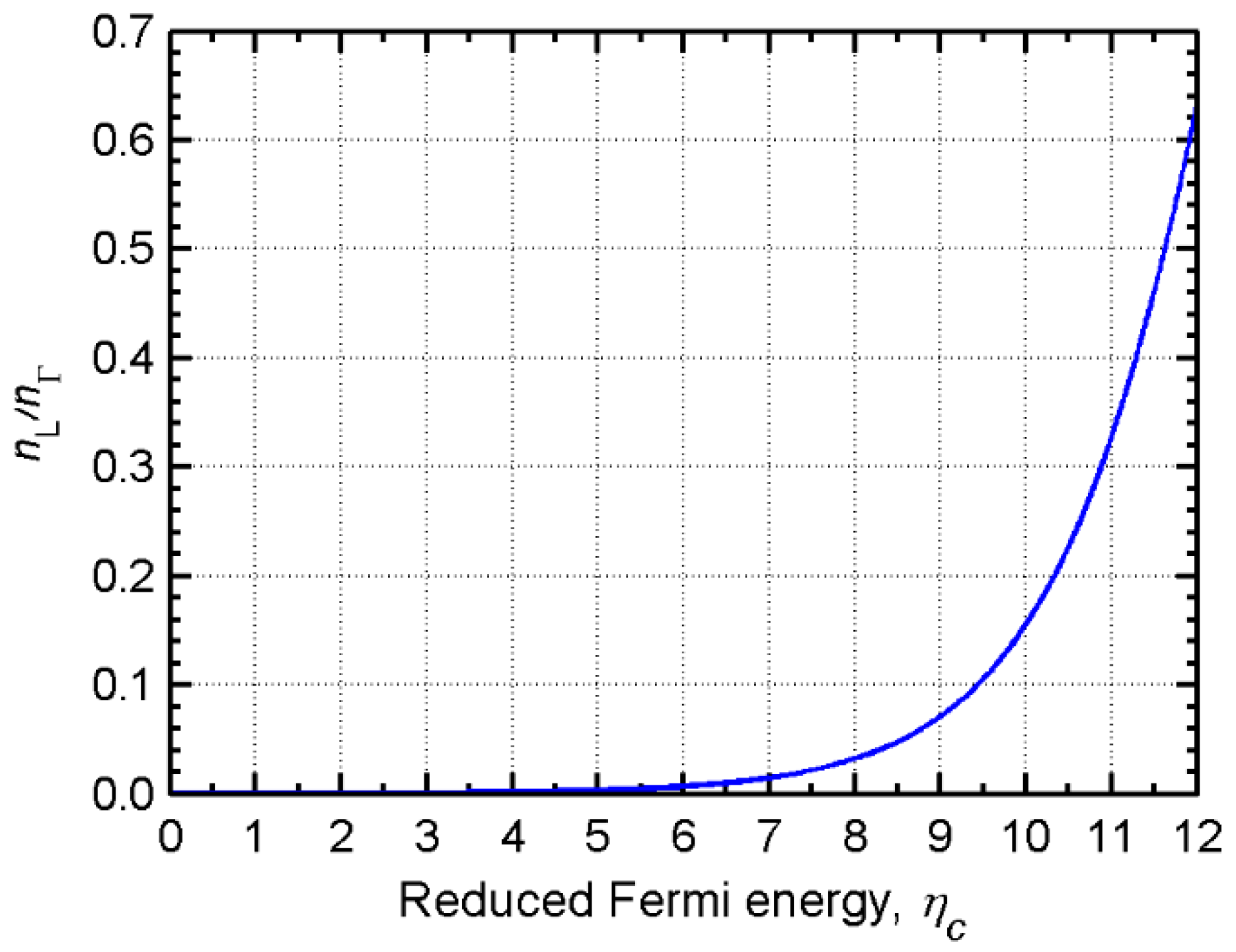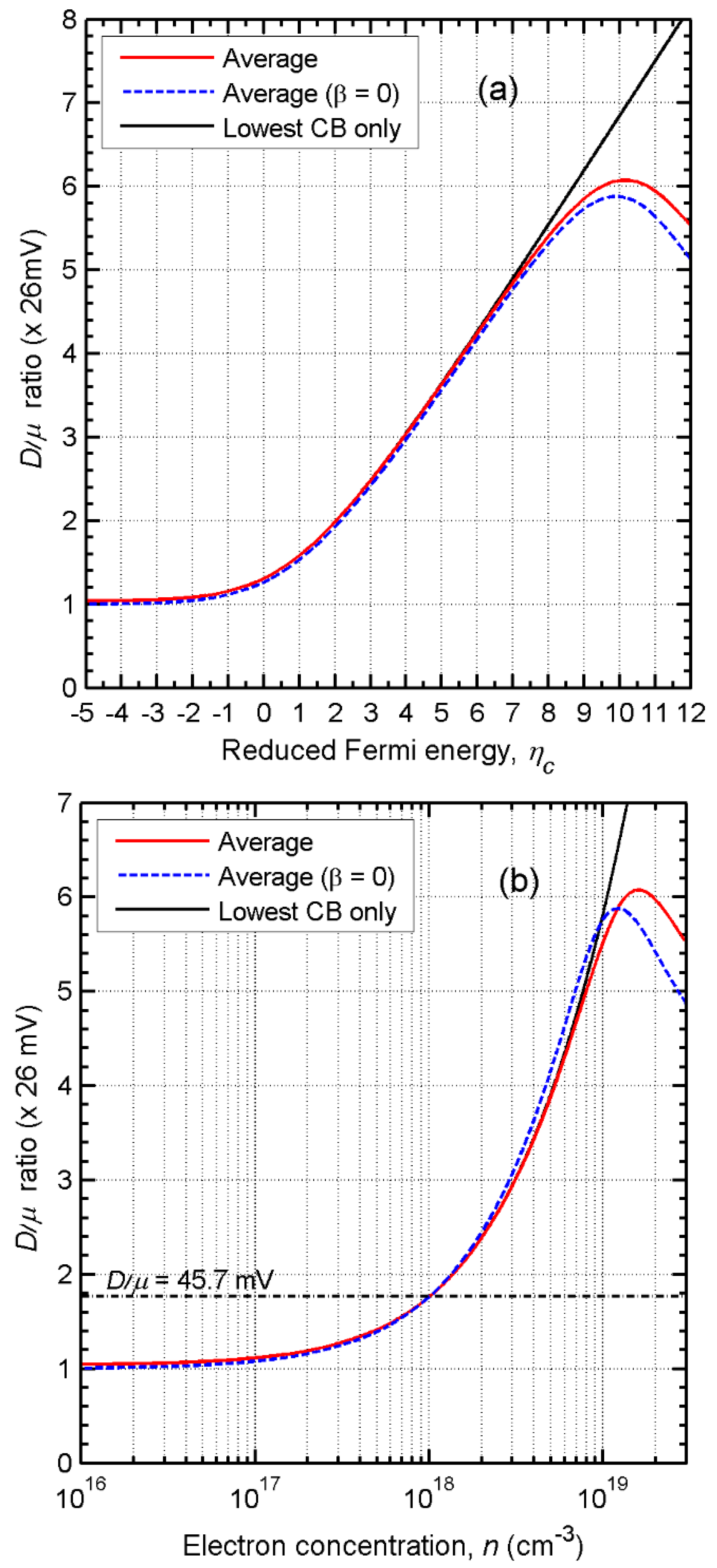1. Introduction
The diffusion coefficient (D) and mobility (μ) of carriers are critically important fundamental transport parameters for describing the properties of carrier transport in semiconductor devices and materials, and are interconnected to each other through a factor by the Einstein relation. Due to the theoretically sound interconnection between them, the diffusion coefficients are commonly determined from the mobility using the Einstein relation, which therefore plays a key role in semiconductor analysis and device design. However, the values of the factor, i.e., the D/μ ratio, are generally given differently depending on the carrier concentration in an energy band and the electronic structure of the energy band, as well as the carrier temperature.
The Einstein relation was initially derived for particles of Brownian motion based on the ideal gas law and Fick’s law of diffusion [
1]. Therefore, this classical Einstein relation is valid only for particles that obey Maxwell–Boltzmann statistics and have the same mass. Only in such a case, the
D/
μ ratio is given by a constant, and is particularly equal to the value of the thermal voltage for charged particles developing an electric field.
The conventional Einstein relation derived for nondegenerate semiconductors based on the use of Maxwell-Boltzmann statistics with the assumption that the carrier effective mass is constant, i.e., the energy band structure is parabolic, is given by:
where
kB is the Boltzmann constant;
TL denotes the temperature of the semiconductor system in thermal equilibrium, i.e., the lattice temperature (or the carrier temperature) in K; and
q is the positive electronic charge. Even though Equation (1) can be derived separately for carriers in semiconductors by applying the principle of detailed balance to the current equation, or in other ways, its theoretical basis is essentially the same as the classical Einstein relation stated above (the inclusion of
q in Equation (1) is due to the charge of a carrier).
On the bases of Fermi-Dirac statistics and the parabolic energy band assumption, a general Einstein relation that is valid for degenerate, as well as nondegenerate, semiconductors was derived earlier using the concept of the average kinetic energy of electrons in thermal equilibrium, which is given by [
2]
and it was shown that the
D/
μ ratio for electrons is approximately equal to (2/3)
/
q, where
is the Fermi energy (FE), and
refers to the conduction band (CB) bottom energy, for metals and strongly degenerate semiconductors. The Einstein relation for carriers in semiconductors was also investigated using an expression (
) derived in terms of the chemical potential,
, and it was shown that in general, the
D/
μ ratio depends on carrier concentration, rather than being constant, and is proportional to
n2/3 for highly degenerate semiconductors [
3]. By employing the principle of detailed balance, an expression equivalent to Equation (2a), but simpler, was also derived, such as [
4,
5]:
In these equations,
F1/2(
ηc) and
F−1/2(
ηc) refer, respectively, to Fermi-Dirac integrals of order 1/2 and −1/2, which is given as a function of the reduced Fermi energy defined by:
Note that Equation (2b) can be obtained from Equation (2a) if the recurrence relation of Fermi-Dirac integrals is utilized. The former simpler Equation (2b) is commonly referred to as the generalized Einstein relation for electrons, but it is valid only for semiconductors having parabolic energy bands. This generalized Einstein relation is often formulated in a different form, such as [
6,
7,
8]:
where
n is the electron concentration. However, this form is equivalent to Equation (2b), due to the following identities:
where
Nc denotes the effective density of states (DOS) for parabolic CB cases, and the recurrence property of Fermi-Dirac integrals has been used.
The experimentally established Fick’s law asserts that the diffusive flux of particles at a local spatial point is simply proportional to the spatial gradient of the particle concentration. In this macroscopic law, the proportional parameter (the diffusion coefficient) represents the average property of a particle for diffusion. However, we see in Equation (2b) that, due to the microscopic property of carriers’ quantum mechanical behavior, the additional factor F1/2(ηc)/F−1/2(ηc) appears when Fermi-Dirac statistics are adopted. This causes the D/μ ratio, representing an average property, to depend on a spatial position, even though all of the electrons have the same effective mass and are subject to the same macroscopic temperature.
The direct reason for the appearance of the additional factor is, of course, due to the carrier concentration being given by a Fermi-Dirac integral in Fermi-Dirac statistics. However, the underlying physical reason for its appearance beyond such a somewhat mathematical reason has not yet been addressed, and is clarified in detail in the following. Let us consider a fixed number
N of degenerate electrons distributed in a certain parabolic CB. We assume that they have been restricted to be redistributed over energy states according to Maxwell-Boltzmann statistics by some external means. Recall that Maxwell-Boltzmann statistics permits any number of electrons to occupy the same quantum (spin) state [
9]. Now, if we remove the external restricting condition, it is expected that a large fraction of the electrons sharing the same quantum states with a higher probability of occupation at a lower energy will jump over to higher-energy empty states to accommodate Pauli’s exclusion principle, the key law in Fermi-Dirac statistics. This will give rise to an increase in the average kinetic energy of electrons from the average value that resulted from the Maxwell-Boltzmann statistics, essentially leading to a larger kinetic pressure of the electron gas. Therefore, for a given mobility, the diffusivity of the
N electrons will be larger due to their greater energetic kinetic motion, on average. In fact, this effect is reflected by the additional factor. Note that the factor
F1/2(
ηc)/
F−1/2(
ηc) is always larger than unity for any values of
ηc. Thus, for a parabolic energy band, a larger value in the
D/
μ ratio is always generated even for the nondegenerate condition (
ηc < −3) when Fermi-Dirac statistics is applied.
In semiconductors, nonparabolicity always exists in their energy band structures. The nonparabolicity effect on carrier transport is technically important, particularly for direct-bandgap compound semiconductors with high electron mobility, since they can have significant nonparabolicity in their central conduction valleys, which feature isotropic constant surfaces of energy. This necessitates a more generalized Einstein relation, beyond Equation (2b) or Equation(4), which can properly take into account the nonparabolicity effect.
Using an approximate Kane’s dispersion relation [
10,
11], a more generalized Einstein relation for degenerate semiconductors with nonparabolic energy bands was also derived earlier [
12], and the result has often been utilized [
13,
14,
15]. This existing generalized Einstein relation for electrons in nonparabolic CBs is given by:
where
α is the nonparabolicity parameter, usually expressed in the unit of eV
−1, for the isotropic CB; and
F3/2(
ηc) is the Fermi-Dirac integral of order 3/2. Note that Equation (6) was obtained by assuming that
α(
) << 1, where
is the electron energy, in order to simplify the density integral (refer to Equation (14)) in a closed form by the binomial approximation.
Concerning the formula of Equation (6), however, two theoretically serious defects are pointed out here: (1) due to the adoption of the binomial approximation for the derivation, it produces large errors for large values of
α or
TL (see
Figure 1); and (2) in the nondegenerate condition, it reduces to the conventional Einstein relation, Equation (1), derived for parabolic energy bands, since all of the Fermi–Dirac integrals are almost equal in value if
ηc < −3. However, this aspect is physically improper. The reason is explained in the following. Let us consider two different cases of CBs, in which both bands have the same value of
mc (the electron effective mass at the band bottom), but one is parabolic (
α = 0) and the other is nonparabolic (
α > 0). For the case of
α = 0, the DOS in three-dimensional
k-space (momentum space) is uniformly equal throughout the space. However, for the case of
α > 0, the DOS increases continuously as the magnitude of
k increases from zero (the energy minimum point) [
16], since the energy-dependent effective mass for electrons increases continuously as the energy increases. Therefore, for a given FE, the average kinetic energy of electrons is always given more largely in the case of
α > 0, resulting in a larger diffusivity of electrons for a fixed mobility, as already explained above. In other words, if nonparabolicity exists in an energy band, we always have a larger
D/
μ ratio for any values of
ηc, i.e., even for the nondegenerate condition, than that expected by the parabolic band approximation.
If the binomial approximation is applied for the density integral, the electron concentration can be approximated by:
Substituting this equation into Equation (4), we simply obtain Equation (6). Therefore, the existing generalized Einstein relation for nonparabolic energy bands is a simple modification of the carrier concentration to the generalized Einstein relation for parabolic energy bands, so that it disregards the carrier thermal energy diffusion effect arising from the thermal kinetic motion of carriers. The consequence is that it produces a physically improper
D/
μ ratio, as can be verified in
Section 4.
The formulas of the Einstein relation (1), (2b), (4), and (6) were derived in thermal equilibrium or near-equilibrium conditions by various approaches, typically based on the principle of detailed balance or the Boltzmann transport equation (BTE), respectively. In the present paper, a new, much more generalized Einstein relation for degenerate semiconductors with isotropic nonparabolic energy bands is derived rigorously based on the semiclassical momentum balance equation that was obtained from the BTE, by assuming a near-equilibrium transport condition, as specified in
Section 3, and formulated to be utilized for semiconductors, particularly with accuracy for direct-bandgap semiconductors where their lowest CB structures can be approximated by Kane’s dispersion relation. It is known that Kane’s band model is not valid for high electron energies (e.g., above about 0.5 eV from
in the case of Si) [
16]. However, it is presented in
Section 4 that the
D/
μ ratio for conduction electrons in a semiconductor is not affected generally by the electronic property of a band structure above 0.4 eV from the CB edge at room temperature.
The derivation of the new formula employs a new concept of the effective temperature of a carrier gas for the generalization of the classical kinetic theory, which is introduced in the present paper for the first time. Therefore, it is first necessary to describe this concept prior to the derivation. According to the equipartition theorem, the average translational kinetic energy,
w, of a carrier gas in a semiconductor in thermal equilibrium conditions is related to the carrier temperature or the semiconductor lattice temperature
TL as:
However, it is essential to realize that, strictly speaking, the factor 1/2 in this equation holds only for ideal gases, such that: (1) all of the particles have the same mass (e.g., electrons in parabolic energy bands); and (2) there is no interaction among particles, except during elastic collisions (Maxwell–Boltzmann statistics is applicable, i.e., particles are not subject to Pauli’s exclusion principle). Therefore, for carriers in degenerate semiconductors with parabolic energy bands or carriers in semiconductors with nonparabolic energy bands, the two conditions of (1) and (2) do not hold, so that Equation (8) is not valid. Generally, the average kinetic energy
w of a gas of particles is a function of particle temperature and particle concentration. For ideal gases, the energy is a function of particle temperature only, and the factor 1/2 holds. Otherwise, this factor is given differently. In thermal equilibrium, the carrier temperature must be equal to the semiconductor lattice temperature. Therefore, by introducing the effective temperature of a carrier gas,
TE, for the generalization of the classical kinetic theory for nonideal gases of carriers, the equipartition theorem of Equation (8) can be modified to the following form of a generalized expression:
In the following section, the effective temperature of electrons in nonparabolic energy bands is thus derived first, and then the new generalized Einstein relation is derived and formulated in the subsequent section.
2. The Effective Temperature of Electrons in Thermal Equilibrium
Kane’s dispersion relation for isotropic nonparabolic CBs is given by:
where
ħ is the reduced Plank’s constant;
k is the magnitude of the wave vector
k; and
mc denotes the electron effective mass at
, as defined previously. The electron concentration and the thermal kinetic energy density of electrons can be evaluated simultaneously from the following density integral moment equation by introducing a moment parameter
λ:
where
f(
k) is the probability function for an electron near
k, and the integration is over all
k-space within the band (in the first Brillouin zone). If
λ = 0, Equation (11) yields the electron concentration, and if
λ = 1, the thermal kinetic energy density. In thermal equilibrium, the distribution function
f(
k) is given by the isotropic Fermi–Dirac distribution function. Therefore, by substitution, we have:
Differentiating Equation (10) with respect to
k gives:
Substitution of Equations (10) and (13) into Equation (12) yields:
where
h is Plank’s constant and a dimensionless parameter
β =
αkBTL has been introduced. The integration variable is defined by
x = (
)/(
kBTL), and
Nc, the effective DOS, is given by:
In the present work, the square-root part involved in the integral of Equation (14) is approximated by choosing a suitable fitting number for the coefficient of the linear term empirically based on the following expansion property:
The accuracy of this empirical approximation for Equation (14) has been numerically calculated in the case of
λ = 1 (larger errors are resultant for
λ = 1 than
λ = 0), and the results are depicted in
Figure 1. Note that the approximation is quite accurate with a maximum error of less than 2% over a very wide range of
ηc for the extensive variation of
β values. In the same figure, calculated errors induced by the binomial approximation are also depicted in dashed curves typically for
β = 0.12 and 0.18 for comparison. As shown, the errors of this approximation increase largely with the FE for
ηc > 3, and in particular, the error is significantly larger for the large value of
β = 0.18 at Fermi energies of
ηc > 5.
By using the empirical approximation, the density moment equation is evaluated as follows:
By letting
λ = 0 and
λ = 1, the electron concentration and the thermal kinetic energy density are obtained, respectively, as:
and
where
for the Fermi–Dirac integral of order
j.
Finally, from Equations (9), (18) and (19), the effective temperature of electrons for nonparabolic energy bands is obtained as:
From this equation, it is worth noting that, for nonparabolic CBs where
β > 0, we always have
TE >
TL for any values of
ηc. For parabolic CBs where
β = 0, Equation (21) gives
TE ≈
TL for the nondegenerate condition and
TE =
F3/2(
ηc)/
F1/2(
ηc)
TL generally.
3. Derivation of the New Generalized Einstein Relation
The derivation uses the semiclassical momentum balance equation that was derived from the BTE by the method of moments for describing the macroscopic transport properties of electrons in a single conduction valley with a nonparabolic energy band structure (for Equation (23), refer to
Appendix A) [
13,
17]:
and
where
t is the time;
P,
v, and
T are the momentum density, the average velocity (i.e., the drift velocity), and the electron temperature tensor, respectively;
E is the electric field; and
vo represents a drift velocity equal to the electron velocity at the wave vector
ko in
k-space (
ko and
(
w) are defined following Equations (24) and (25), respectively). The variable
Q thus represents the total kinetic energy density tensor that has combined three tensor quantities: the first quantity corresponds to a kinetic pressure tensor of the electron gas due to the random thermal motion of electron particles deviated from their average velocity in velocity space [
17], or their average momentum in
k-space (see Equation (25)); the second corresponds to a kinetic energy density tensor associated with the group drift motion in real space; and the third corresponds to a kinetic energy density tensor appearing due to the difference in magnitude between the two velocities of
v and
vo. For parabolic energy bands,
v equals
vo, so that this density tensor becomes zero. In particular, the divergence of the second tensor quantity represents the rate of local outflow of the momentum density, and is responsible for the appearance of a velocity convection term in the momentum balance equation when expressed in terms of drift velocity. This convection term is usually neglected in high-field transport device simulations for numerical convenience. If the total energy density tensor
Q is written in matrix form, then
Qαβ =
nkBTαβ +
vαPβ +
Pα(
vβ −
voβ) for
α and
β =
x,
y,
z (space coordinates) with
Tαβ,
vα,
vβ,
Pα,
Pβ, and
voβ the corresponding components of
T,
v,
P, and
vo, respectively.
The collision term in Equation (22) accounts for the rate of change in momentum density due to carrier scattering. Under the usual relaxation-time approximation [
18], this term becomes −
P/
τm(
w), where
τm(
w) is the average momentum relaxation time, so that Equation (22) in the steady-state condition is simplified to
where
μ =
qτm(
w)/
m*(
w) is the mobility, with
m*(
w) being the average conductivity effective mass (the mobility is thus dependent on
w, but a simple notation has been used). The energy-dependent parameters
τm(
w) and
m*(
w) are usually determined by Monte Carlo simulations in stationary transport conditions. The momentum density and the average velocity are related to each other through the average conductivity effective mass by
P =
nm*(
w)
v. In addition, the momentum density is given by
P =
n<
ħk> =
nħko, where the angle brackets mean the average over all of the electrons, so that
ko denotes the weighted average wave vector in
k-space. The temperature tensor is obtained as (see
Appendix A):
where
mk =
mc(1 + 2
α), which is the electron mass associated with the group velocity of an electron wave packet at the state of
k [
13,
16,
19]. The magnitude of
m*(
w) is not equal to that of <
mk> =
mc(1 + 2
αw), which is defined by
(
w), for nonparabolic energy bands, and lies between the magnitudes of
(
w) and
mc(1 + 2
αw)
3, depending on the electric field strength [
20]. At low applied electric fields,
m*(
w) and
(
w) are approximately equal in magnitude in stationary transport conditions.
In order to derive the new generalized Einstein relation strictly, a near-equilibrium transport (NET) condition is assumed, such that at each local point of a semiconductor region, the average drift kinetic energy of carriers is negligibly very small so that their average kinetic energy, w, does not change perceivably by an applied electric field from the value of their average thermal kinetic energy obtained in near-equilibrium, i.e., the average thermal kinetic energy that is given for carriers of the same concentration in thermal equilibrium. In the following, this thermal energy will be referred to as the equilibrium average thermal kinetic energy, and the corresponding nondisplaced distribution function of carriers as the equilibrium distribution function. It should be mentioned that in semiconductor devices, the carrier concentration in near-equilibrium generally differs and can deviate significantly from its value in thermal equilibrium when an electric field has been applied. A typical example is the case of carriers being injected from the junction into an opposite-type semiconductor region and transported diffusively as minority carriers in a p-n junction diode. The NET condition assumed then means collaterally that: (1) the carriers practically retain thermal equilibrium with the lattice during their transport by releasing their energy gained from the electric field to the lattice rapidly through scattering, so that the transport of carriers is stationary (i.e., under a local-transport condition); (2) since the carriers are little heated and hence their distribution function does not expand perceivably by a local electric field, it is only displaced in k-space in proportion to the strength of the field (generally, a local driving force, electric or diffusive), so that the transport characteristic of carriers is linear (i.e., carrier velocity response to a local driving force is linear); and (3) since the average drift kinetic energy of carriers is so small, the displacement of the distribution function is not large, so that the carrier concentration can be approximated properly by using the equilibrium distribution function of carriers centered at k = 0 for isotropic nonparabolic energy bands where the DOS is distributed nonuniformly in k-space. The reason is associated with the spherical symmetricity existing in both the structure of the energy band and the distribution function of the carriers, which causes the average of the antisymmetric part of the carrier distribution in k-space to be approximately zero in the NET condition. Note that for parabolic energy bands, the carrier concentration is not changed by any mere displacement of the distribution function in k-space due to a uniformly distributed DOS in k-space. Thus, it should be noted that the generalized Einstein relation to be derived in this section is invalid if any of these detailed three subconditions of the NET condition is not satisfied.
Therefore, it follows from the assumption that: (1) all of the drift kinetic energy tensor components of
vαPβ, as well as
Pα(
vβ −
voβ), can be neglected; and (2) all of the non-diagonal components of
T, i.e.,
Tαβ with
α ≠
β, completely vanish, due to the existence of the isotropic symmetricity in both the band structure and the distribution function in the NET condition. In addition, all of the diagonal components of
T, i.e.,
Tαβ with
α =
β, are almost equal in magnitude (not exactly equal for nonparabolic energy bands due to a displacement of the distribution function). As a result, a scalar electron temperature
T can be defined justly so that
T =
Tδ, where
δ is the unit dyad. From these results of (1) and (2), Equation (24) reduces to the following drift–diffusion equation:
where
In the NET condition, the average thermal kinetic energy remains the same as the equilibrium average thermal kinetic energy, so that the electron temperature
T becomes dependent only on the local FE, which in turn uniquely determines the electron concentration, or vice versa. Therefore,
Q =
Q(
n,
T) becomes a function of only one independent variable,
ηc. In other words,
Q =
Q(
ηc(
n(
x,y,z))). Consequently, the application of the chain rule for differentiation to Equation (26) results in:
where
and
Note that, in Equation (30), the electron temperature
T has been reduced to the effective temperature of electrons in thermal equilibrium,
TE, due to the fact that
T ≈
TE under the NET condition, and
W is the total thermal kinetic energy density in thermal equilibrium, as defined in
Section 2.
Equation (29), including Equation (30), is the new, much more generalized, macroscopic equation of the Einstein relation which can take into account the effect of thermal energy diffusion of carriers completely for degenerate semiconductors with isotropic nonparabolic energy bands. It is worth noting that this new generalized macroscopic equation reduces to Equation (1), the conventional Einstein relation for nondegenerate semiconductors with parabolic energy bands, for TE = TL, and also to Equation (4), or (2b), the generalized Einstein relation for degenerate semiconductors with parabolic energy bands, for TE = F3/2(ηc)/F1/2(ηc)TL and n = NcF1/2(ηc), since dQ/dηc = kBTLn then.
In the NET condition, the concentration
n is approximately equal to the concentration value given by the equilibrium distribution function of carriers for an arbitrary value of the FE (generally quasi-FE), as described in subcondition (3). Therefore, substituting Equations (18) and (21), or Equation (19), into Equations (29) and (30) yields the following new generalized formulation of the Einstein relation for electrons in isotropic nonparabolic energy bands:
where the recurrence property of Fermi–Dirac integrals has been used such that:
For
β = 0, the new formula reduces to Equation (2b), as well as Equation (1) in the nondegenerate condition. The corresponding generalized macroscopic equation and formula for valence holes in an isotropic nonparabolic band can be written directly from Equations (29)–(31). Equation (31) contains several Fermi–Dirac integrals, but they can be evaluated comfortably using a computer software package for mathematics. In addition, analytical expressions for approximating all of these integrals in a convenient form with reasonable accuracy is obtained in Reference [
21]. Also note that in the nondegenerate condition, the Fermi-Dirac integrals included in both the numerator and denominator in Equation (31) are almost canceled, resulting in the following simple expression of the
D/
μ ratio that does not depend on the FE:
In other words, in the nondegenerate condition, the population of carriers over energy states in an energy band is not dense, so that Maxwell–Boltzmann statistics can be used as a very good approximation.
The validity limit of the new generalized macroscopic equation and formula for applied electric fields is discussed. Monte Carlo simulations performed for bulk materials at
TL = 300 K show that the average electron energy (or the electron temperature) remains almost constant up to an electric field strength
E = 2 kV/cm for GaAs [
22], and
E = 3 kV/cm for InP [
23]. The doping densities of the materials were
ND = 2 × 10
17 cm
−3 and
ND = 10
17 cm
−3, respectively. The drift velocity for
E = 2 kV/cm is
v = 9 × 10
6 cm/s for the former case, and
v = 9.6 × 10
6 cm/s for the latter, when calculated by
v =
μE (with
μ = 4500 cm
2/V-s for GaAs and
μ = 3200 cm
2/V-s for InP). It has been shown by calculations that the ratio of the drift kinetic energy,
m*(
w)
v2/2, to the average thermal kinetic energy in thermal equilibrium, which is equal to 3
kBTE/2, is negligibly small and less than 5% in both cases. This fact is in agreement with the assumption adopted in the derivation. Such a theoretical analysis indicates that the new macroscopic equation and formula can be valid for applied electric fields up to the upper velocity and field bounds of the linear regime (in the velocity-field relation) for conduction electrons of direct-bandgap semiconductors (
v < 10
7 cm/s due to possible velocity overshoot). In this type of semiconductor, which usually features high electron mobility, the mean thermal velocity (
vth) of electrons is commonly large due to their small effective mass (typically, for GaAs
vth ≈ 4.5 × 10
7 cm/s in the nondegenerate condition at room temperature), so that the upper velocity bound of the linear regime is generally high for direct-bandgap semiconductors.
The generalized Einstein relation expressed by the macroscopic equation and the formula is dependent only on the spatial variation of the FE, i.e., the carrier concentration, and independent of the electric field. Therefore, the validity limit discussed above for direct-bandgap semiconductors generally holds for other types of semiconductors as well (of course, in the validity limits of isotropic nonparabolic band approximations). Since it has been derived on the basis of the BTE, its applications should be limited within the validity limits of the BTE. Note that this equation is valid only when the spatial variation of the potential in a semiconductor device is slow on the scale of the De Broglie wave length, which is typically 10 to 20 nm [
16]. Therefore, for a small scaled device where the carrier concentration changes rapidly with position, the BTE itself is invalid.
5. Conclusions
The currently used generalized Einstein relation for degenerate semiconductors with isotropic nonparabolic energy bands produces physically improper results, as well as losing numerical accuracy for large values of nonparabolicity parameters at room temperature. Therefore, a new generalized Einstein relation (a macroscopic equation and a formula) for degenerate semiconductors with isotropic nonparabolic energy bands was derived from the semiclassical momentum balance equation based on a drift–diffusion approximation by assuming a near-equilibrium transport condition. For the derivation, the novel concept of the effective temperature of a carrier gas has been introduced for the generalization of the classical kinetic theory for nonideal gases of carriers in semiconductors. The new generalized Einstein relation takes into account the carrier thermal energy diffusion effect completely, so that it can correctly reflect the effect of band nonparabolicity on the D/μ ratio for carriers in degenerate semiconductors with isotropic nonparabolic energy bands.
A theoretical analysis of the validity limit of the new Einstein relation for applied electric fields was also performed. The result indicates that it is generally valid for applied electric fields of the full linear regime for conduction electrons in semiconductors.
Many important nonparabolicity effects on the D/μ ratio for carriers in semiconductors were newly observed, and are summarized in the following. For any given FE, band nonparabolicity causes the D/μ ratio to always increase, and the nonparabolicity effect is largest in the nondegenerate condition. However, the effect is very different for a given electron concentration. In other words, band nonparabolicity causes the D/μ ratio to always increase in the nondegenerate condition, but it causes the D/μ ratio to always decrease in the high degenerate condition. Therefore, quite an interesting feature appears, such that for semiconductors with isotropic nonparabolic energy bands, when the electron concentrations are equal to the value of 2.33Nc, the D/μ ratios are always nearly equal to the value of 1.77kBTL/q, irrespective of the degree of nonparabolicity of their CBs.
The results calculated for common direct-bandgap compound semiconductors have additionally shown the following specific aspects for the nonparabolicity effect on the D/μ ratio for conduction electrons. For compound semiconductors that have a very wide direct bandgap, such as GaN, the nonparabolicity effect is negligibly small and can be disregarded. It is also negligibly small in the nondegenerate condition for direct-bandgap compound semiconductors, such as GaAs and InP, that have a relatively large bandgap energy. However, it can be significantly large in heavy-doping conditions in these semiconductors. This is another newly observed and critically important aspect. On the other hand, for compound semiconductors, such as InAs and InSb, that have a narrow direct bandgap, the nonparabolicity effect is substantially large in both the nondegenerate condition and the high degenerate condition. Therefore, the use of the parabolic band approximation for these semiconductors can give rise to considerable errors for the diffusion coefficients of electrons.
The dependency of the D/μ ratio and the FE on the electron concentration (or doping density in homogeneous materials) for a given semiconductor can be easily determined from the figures presented in the work. Therefore, they should be quite useful for semiconductor device design and material analysis. The generalized Einstein relation formulated in the present work can be utilized to more accurately analyze various depletion phenomena in semiconductor devices and materials in thermal equilibrium or near-equilibrium conditions, and also minority carrier diffusion properties in low-field or charge-neutral active regions of semiconductor devices, typically such as p-n diodes and bipolar transistors.
